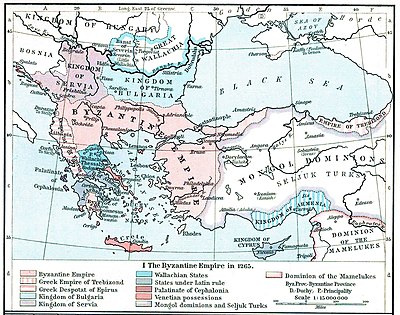Naxos: Difference between revisions
No edit summary |
|||
| Line 26: | Line 26: | ||
}} |
}} |
||
'''Naxos''' ([[Greek language|Greek]]: Νάξος; [[Italian language|Italian]]: '' |
'''Naxos''' ([[Greek language|Greek]]: Νάξος; [[Italian language|Italian]]: ''Nasso''; [[Turkish language|Turkish]]: ''Nakşa'') is a [[Greece|Greek]] island, the largest island (428 km²) in the [[Cyclades]] island group in the [[Aegean Sea|Aegean]]. It was the centre of archaic [[Cycladic culture]]. |
||
The largest city and capital of the island is Hora, sometimes called Naxos City, with about 12,000 inhabitants. The main villages are Filoti, Apiranthos, Tragea (Chalki), Koronos, Sangri, and Apollonas. |
The largest city and capital of the island is Hora, sometimes called Naxos City, with about 12,000 inhabitants. The main villages are Filoti, Apiranthos, Tragea (Chalki), Koronos, Sangri, and Apollonas. |
||
Revision as of 21:53, 6 June 2007
Naxos
Νάξος | |
|---|---|
Settlement | |
 Naxos City | |
| Country | Greece |
| Administrative region | South Aegean |
| Area | |
| • Total | 428 km2 (165 sq mi) |
| Highest elevation | 11 m (36 ft) |
| Lowest elevation | 0 m (0 ft) |
| Population (2006) | |
| • Total | 25,089 |
| • Density | 59/km2 (150/sq mi) |
| Time zone | UTC+2 (EET) |
| • Summer (DST) | UTC+3 (EEST) |
| Postal code | 843 xx |
| Area code(s) | 22850 |
| Vehicle registration | ΕΜ |
Naxos (Greek: Νάξος; Italian: Nasso; Turkish: Nakşa) is a Greek island, the largest island (428 km²) in the Cyclades island group in the Aegean. It was the centre of archaic Cycladic culture.
The largest city and capital of the island is Hora, sometimes called Naxos City, with about 12,000 inhabitants. The main villages are Filoti, Apiranthos, Tragea (Chalki), Koronos, Sangri, and Apollonas.
Naxos is a popular tourist destination, with several easily accessible ruins. It has many beautiful beaches, such as those at Agia Anna, Agios Prokopios, Alikos, Kastraki, Mikri Vigla, Plaka, and Agios Georgios, most of them near Hora.
Naxos is the most fertile island of the Cyclades. It has a good supply of water in a region where water is usually inadequate. Mount Zas (1,008 metres) is the highest peak in the Cyclades, and tends to trap the clouds, permitting greater rainfall.
Mythic Naxos

According to a story in Greek mythology, the young Zeus was raised in a cave on Mt. Zas ("Zas" meaning "Zeus").
Homer mentions "Dia"; literally the sacred island "of the Goddess". Karl Kerenyi, speaking for the ancient Greeks, explains:
- "This name, Dia, which means 'heavenly' or 'divine', was applied to several small craggy islands in our [ Aegean ] sea, all of them lying close to larger islands, such as Crete or Naxos. The name "Dia" was even transferred to the island of Naxos itself, since it was more widely supposed than any other to have been the nuptial isle of Dionysus." (Kerenyi 1951 pp271-2)
One legend has it that in the Heroic Age before the Trojan War, on this island Theseus abandoned Ariadne, daughter of Minos, King of Crete, after she had helped him kill the Minotaur and to escape from the Labyrinth. Dionysus, god of the island and protector of wine, festivities, and the primal energy of life, met her and fell in love with her. But eventually Ariadne, unable to bear her separation from Theseus, killed herself, according to the Athenians, or ascended to heaven, as the older versions had it.
According to another mythological story, the Aloadae had piled Mt. Ossa and Mt. Pelion on top of each other in front of Mt. Olympus, and were seen as a threat to the gods. To solve this problem, Artemis told Otus, one of the two brothers, that if he shall stop the siege of the Olympus she would come and be his lover at Naxos. Another story says that the Aloadae had actually settled Naxos.
Historical population
| Year | Communal population | Change | Municipal population | Change | Island population | Change | Density |
|---|---|---|---|---|---|---|---|
| 1981 | 3,884 | - | - | - | 14,037 | - | 32.8/km² |
| 1991 | 4,334 | +450/+11.59% | 9,824 | - | 14,838 | +801/+5.71% | 34.69/km² |
| 2001 | - | - | 12,089 | +2265/+23.06% | - | - | - |
History
Revolt of Naxos
In 502 BCE the inhabitants of Naxos rebelled against their masters in the Persian Empire; this revolt led to the larger Ionian Revolt, and then to the Persian War between Greece and Persia.
Greek and Byzantine Naxos
During the 8th and 7th centuries BCE, Naxos dominated commerce in the Cyclades.
This section needs expansion. You can help by adding to it. |
The Dukes of Naxos

In the aftermath of the Fourth Crusade, with a Latin Emperor under the influence of the Venetians established at Constantinople, the Venetian Marco Sanudo conquered the island and soon captured the rest of the islands of the Cyclades, establishing himself as Duke of Naxia, or Duke of the Archipelago. Twenty-one dukes in two dynasties ruled the Archipelago, until 1566; Venetian rule continued in scattered islands of the Aegean until 1714.
Ottoman Naxos (1564-1821)
The Ottoman administration remained essentially in the hands of the Venetians; the Porte's concern was satisfied by the returns of taxes. Very few Turks ever settled on Naxos, and Turkish influence on the island is slight. Turkish sovereignty lasted until 1821, when the islands revolted; Naxos finally became a member of the Greek state in 1832.
Other
Naxos has schools, lyceums (middle schools), gymnasia (secondary school), churches, a post office and squares (plateies).
Reference
- Kerenyi, Karl 1951. The Gods of the Greeks.
See also
External links
- WikiTravel page on Naxos
- Sites and Photos - Images of Naxos
- Naxos Island in 300 images
- Location, with links to aerial photos and maps: 37°5′00″N 25°28′00″E / 37.08333°N 25.46667°E
